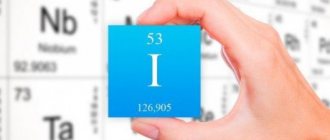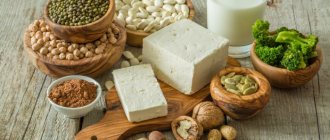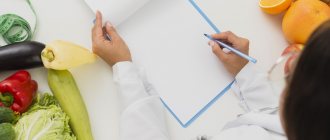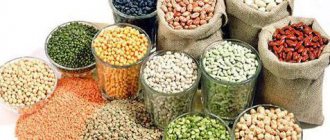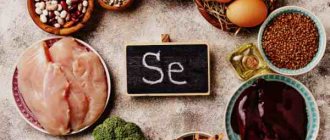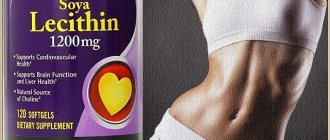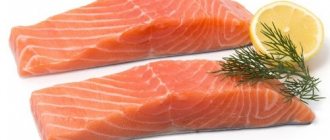How much iodine does a person need per day?
As we have already noted, a healthy person needs 100-200 mcg of iodine per day. However, this figure may change under the influence of a number of factors:
| A group of people | Daily iodine requirement, mcg |
| infants up to 12 months | 90-120 |
| preschool children | 120 |
| children 7-9 years old | 140-150 |
| children 10-12 years old | 180-200 |
| teenagers and adults up to 35 years old | 200 |
| adults over 36 years old | 180 |
| pregnant women | +30 mcg to normal for age |
| nursing women | +60 mcg to normal for age |
The human body is not able to synthesize iodine. We get it from food, water and air. Residents of Mediterranean countries practically never have a shortage of this microelement, since their diet is rich in fish and seafood. In addition, the coastal air itself contains a significant amount of iodine.
It is more difficult for residents of all other regions: according to statistics, almost two billion people on our planet have some degree of iodine deficiency. To cope with this problem, it is important to saturate your diet with seafood and fish. They allow the body to most effectively replenish iodine deficiency. As for vitamin complexes and food supplements with this microelement, they should be taken only as prescribed by your doctor.
Products containing iodine
Here are the main iodine-containing foods that must be present in your diet:
| Product name | Iodine content, mcg |
| sea fish | 400 |
| dried porcini mushrooms | 350 |
| seaweed | 300 |
| squid | 300 |
| River fish | 200-300 |
| feijoa | 80-300 |
| shrimps | 190 |
| hake | 160 |
| pollock | 150 |
| cocoa | 117 |
| mackerel | 100 |
| blueberry | 70 |
| herring | 60 |
| oysters | 60 |
| tuna | 50 |
| flounder | 50 |
| spinach | 20 |
| chicken eggs | 12 |
| beef | 12 |
| bread | 9 |
| Black tea | 8 |
| radish | 8 |
| potato | 3,5 |
Antagonist products
Along with foods that saturate our body with iodine, there are a number of so-called antagonist substances. They destroy iodine molecules, preventing the thyroid gland and other internal organs from receiving sufficient quantities of this trace element:
- Some legumes, flax seeds, all types of raw cabbage. These products contain substances that slow down the absorption of iodine. Frequent consumption of such foods can lead to serious deficiency of this substance.
- A number of medicines - penicillin, sulfonamides, streptomycin, erythromycin, chloramphenicol, aspirin, some hormonal drugs, etc. When taking them, the possibility of developing an iodine deficiency state should be excluded.
- Some chemicals are fluorine, chlorine and bromine. They displace iodine from any compounds, preventing it from penetrating the body tissues. Therefore, if you drink chlorinated water or use bromine-based medications, be sure to consult your doctor about preventing iodine deficiency.
In addition, it should be remembered that this microelement is poorly absorbed in some gastrointestinal diseases, for example, dysbacteriosis.
Features of iodine absorption by the body
Iodine cannot be synthesized in the human body; it must come from the outside: with food, water, special medications and supplements. For an adult, the daily requirement for iodine is around 150 mcg; for athletes, it is advisable to increase the dosage to 200 mcg.
Among residents of “sea” countries, diseases associated with iodine deficiency are rarely recorded, because basic foods from the sea - fish, algae, and seafood - are saturated with it. Residents of the regions of the Far North and regions located in the center of the continents are at risk for iodine deficiency.
Iodine belongs to a chemical group of compounds called halogens. In addition to it, this group includes fluorine, bromine and chlorine. The latter, due to the rules of inorganic chemistry, are capable of displacing iodine from any compounds. Therefore, drinking chlorinated water, excess fluoride-containing products to strengthen tooth enamel, and taking bromine-containing drugs significantly reduce the amount of iodine in the body.
Experts note that special substances contained in cauliflower, red cabbage, turnips, radishes, mustard, soybeans and rutabaga block the absorption of iodine by the body . Therefore, they should not be eaten together with iodine-containing products.
Elements such as manganese, cobalt, selenium, copper accelerate the absorption of iodine , so you need to worry about their intake into the body along with iodine along with food or nutritional supplements.
A lack of protein in the body inhibits the synthesis of thyroid hormones, so the diet must include a sufficient amount of sources of complete protein.
Iodine deficiency: symptoms and consequences
The main symptoms of iodine deficiency include:
- frequent headaches;
- nervousness and irritability;
- high fatigue;
- depressed mood, apathy;
- memory and vision impairment;
- weakening of intelligence;
- poor skin condition;
- drowsiness and frequent headaches;
- deterioration of hair condition, baldness;
- the appearance of edema;
- tendency to frequent colds and infectious diseases;
- decreased sexual function in men;
- menstrual cycle disorders in women.
Even a slight lack of iodine in the human body can lead to serious chronic diseases of the endocrine, cardiovascular, genitourinary and other systems. Very often, with a lack of this microelement, hypothyroidism develops - a pathological decrease in the functions of the thyroid gland.
In children, iodine deficiency can cause slower mental, physical and sexual development. Pregnant women experience this condition even more painfully - they may have a miscarriage or develop various abnormalities in the development of the fetus. In addition, iodine deficiency often leads to metabolic disorders and, as a result, excess weight.
How to identify the body's need for this microelement? This is done quite simply: take a 5% iodine solution and draw a mesh on any part of the body. If after 6-8 hours the lines have completely disappeared, then your body needs this substance. If you turn pale but remain in place, you don’t have this problem. If you identify an iodine deficiency condition, be sure to enrich your diet with the products described in our material, and also consult your doctor to select the most suitable medications for complex treatment.
Excess iodine: symptoms and consequences
Hyperthyroidism - excess iodine in the body - manifests itself as follows:
- increased salivation;
- swelling of the mucous membranes;
- frequent lacrimation;
- allergic reactions in the form of rash and rhinitis;
- cardiopalmus;
- nervousness and insomnia;
- increased sweating;
- diarrhea.
Long-term hyperthyroidism can lead to even more serious consequences, including Graves' disease. In addition, the person may experience seizures, psychic attacks, and even paranoia. Only a doctor can diagnose excess iodine in the body. As a rule, when this problem is identified, he prescribes special medications and a diet with a minimum content of this microelement to the patient.
Beneficial properties of iodine and its effect on the body
Iodine is very important for the body - it is an essential component of the thyroid gland, being part of its hormones (thyroxine, triiodothyronine).
Hormones containing iodine stimulate growth and development, regulate energy and heat metabolism, and enhance the oxidation of fats, proteins and carbohydrates. These hormones activate the breakdown of cholesterol, participate in the regulation of the function of the cardiovascular system, and are important for the development of the central nervous system.
Iodine is a biostimulant and immunostimulant, prevents blood clotting and the formation of blood clots.
Deficiency and excess of iodine
Signs of iodine deficiency
- general weakness, increased fatigue;
- weakening of memory, hearing, vision;
- drowsiness, apathy, headaches;
- weight gain;
- conjunctivitis;
- constipation;
- dry skin and mucous membranes;
- decrease in blood pressure and heart rate (up to 50-60 beats per minute);
- decreased libido in men;
- menstrual irregularities in women.
One of the most characteristic iodine deficiency diseases is endemic goiter.
The amount of iodine in food products of such areas is 5-20 times less in plant products and 3-7 times less in meat than in areas with normal iodine content in nature. In children, iodine deficiency causes retardation in mental and physical development, and their brain and nervous system develop poorly.
Signs of excess iodine
- increased salivation;
- swelling of the mucous membranes;
- lacrimation;
- allergic reactions in the form of rash and runny nose;
- palpitations, trembling, nervousness, insomnia;
- increased sweating;
- diarrhea.
Elemental iodine is very toxic. Early symptoms of poisoning include vomiting, severe abdominal pain and diarrhea. Death can occur due to shock from irritation of a large number of nerve endings.
Excessive intake of iodine can cause Graves' disease.
Factors influencing content in products
Iodine is lost during long-term storage and cooking. When cooking meat and fish, up to 50% is lost, when boiling milk - up to 25%, when boiling potatoes with whole tubers - 32%, and when crushed - 48%. When baking bread, iodine loss reaches 80%, cooking cereals and legumes - 45-65%, cooking vegetables - 30-60%.
Why does iodine deficiency occur?
The iodine content in foods depends on its content in soil and water; there are regions where its content is extremely low, so iodine is often added to salt (iodized salt). For those who deliberately reduce the amount of salt in the diet, this must be taken into account.
Attention! The information is for informational purposes only and is not intended to make a diagnosis or prescribe treatment. Always consult a specialized doctor!
Tatyana Eliseeva chief editor of the Food+ project
Ask a Question
Rating:
9.6
/10
Votes: 23
Usefulness of material 10
Reliability of information 9
Formatting of Article 9.7
Important facts about iodine
- About 10-20% of the total volume of iodine that enters the body immediately “goes” to the thyroid gland. She uses about 75 mcg of this substance daily.
- The process of iodine absorption is accelerated by calcium, selenium, as well as vitamins C, D, E and B vitamins. By the way, all these vitamins and microelements are found in ordinary seaweed and many seafood.
- Iodine is destroyed by fluorine. Therefore, if you regularly use fluoridated toothpastes, be sure to check your body for iodine deficiency.
- Many nutritionists believe that iodized salt is far from the best option for enriching the body with this microelement. The fact is that iodine is destroyed very quickly under the influence of humidity and high temperatures. After boiling or frying, such salt loses its beneficial properties, as well as after. Another way to replenish iodine reserves is to spend a vacation on the sea coast. Experts note that the air in coastal areas is very rich in this microelement.
List of foods high in iodine
Iodine deficiency can be avoided if you include foods containing this element in your daily menu. A large amount of iodine contains:
- Sea kale (300 mcg per 100 g).
- Cranberries (about 350 mcg per 100 g) also contain vitamins C and K, which promote better absorption of iodine.
- Cod (110 mcg per 100 g) is rich in calcium, magnesium, potassium, phosphorus, vitamin E and B vitamins, especially B12, which is involved in the functioning of the cardiovascular system.
- Potatoes (60 mcg per 100 g) contain iron, phosphorus, calcium, zinc, vitamin B6, which properly absorbs proteins and fats and prevents nervous disorders, as well as potassium and magnesium.
- Shrimp (40 mcg per 100 g).
- Turkey breast (47 mcg per 100 g) contains, in addition to iodine, calcium, potassium, zinc, iron, phosphorus and B vitamins.
- White beans (30 mcg per 100 g) contain magnesium, copper, zinc, folic acid, which takes part in the creation of new cells in the body and maintaining their performance.
- Strawberries (13 mcg per 100 g) contain vitamin C, reduce “bad cholesterol” levels and stabilize blood pressure.
- Prunes (13 mcg), to get this amount you only need to eat 5 prunes a day. Prunes are also rich in vitamin K and beta-carotene.
To better understand how much and what foods you should eat per day, check out the daily iodine intake:
WHO recommends that adults consume 120-150 mcg of iodine, and children - 3 mcg per 1 kilogram of weight.
Foods rich in iodine
| The product's name | MCG in 100 g | Percentage of daily requirement |
| Sea kale | 300 | 200% |
| Squid | 200 | 133% |
| Cod | 135 | 90% |
| Shrimp | 110 | 73% |
| Egg powder | 64 | 43% |
| Sea bass | 60 | 40% |
| Low-fat dry milk | 55 | 37% |
| Vobla | 50 | 33% |
| Pink salmon | 50 | 33% |
| Flounder | 50 | 33% |
| Chum salmon | 50 | 33% |
| Atlantic salmon (salmon) | 50 | 33% |
| Powdered milk 25% | 50 | 33% |
| Tuna | 50 | 33% |
| Mackerel | 45 | 30% |
| Fatty herring | 40 | 27% |
| Lean herring | 40 | 27% |
| Chicken egg yolk | 33 | 22% |
| Horse mackerel | 30 | 20% |
| Acne | 20 | 13% |
| Chicken egg | 20 | 13% |
| Champignon mushrooms | 18 | 12% |
| Beans (grain) | 12 | 8% |
| Wheat (grain, durum) | 11 | 7% |
| Wheat groats | 10 | 7% |
| Pistachios | 10 | 7% |
| Yogurt 1.5% | 9 | 6% |
| Yogurt 3.2% | 9 | 6% |
| Kefir 1% | 9 | 6% |
| Kefir 2.5% | 9 | 6% |
| Kefir 3.2% | 9 | 6% |
| Low-fat kefir | 9 | 6% |
| Milk 1.5% | 9 | 6% |
| Milk 2.5% | 9 | 6% |
| Milk 3.2% | 9 | 6% |
| Rye (grain) | 9 | 6% |
| Barley (grain) | 9 | 6% |
Seafood, fish
| The product's name | MCG in 100 g | Percentage of daily requirement |
| Vobla | 50 | 33% |
| Pink salmon | 50 | 33% |
| Squid | 200 | 133% |
| Flounder | 50 | 33% |
| Chum salmon | 50 | 33% |
| Shrimp | 110 | 73% |
| Atlantic salmon (salmon) | 50 | 33% |
| Sea bass | 60 | 40% |
| Fatty herring | 40 | 27% |
| Lean herring | 40 | 27% |
| Mackerel | 45 | 30% |
| Som | 5 | 3% |
| Horse mackerel | 30 | 20% |
| Zander | 5 | 3% |
| Cod | 135 | 90% |
| Tuna | 50 | 33% |
| Acne | 20 | 13% |
| Pike | 5 | 3% |
Dairy and fermented milk products, eggs
| The product's name | MCG in 100 g | Percentage of daily requirement |
| Chicken egg white | 7 | 5% |
| Chicken egg yolk | 33 | 22% |
| Yogurt 1.5% | 9 | 6% |
| Yogurt 3.2% | 9 | 6% |
| Kefir 1% | 9 | 6% |
| Kefir 2.5% | 9 | 6% |
| Kefir 3.2% | 9 | 6% |
| Low-fat kefir | 9 | 6% |
| Milk 1.5% | 9 | 6% |
| Milk 2.5% | 9 | 6% |
| Milk 3.2% | 9 | 6% |
| Goat milk | 2 | 1% |
| Condensed milk with sugar 8.5% | 7 | 5% |
| Powdered milk 25% | 50 | 33% |
| Low-fat dry milk | 55 | 37% |
| Sour cream 30% | 7 | 5% |
| Egg powder | 64 | 43% |
| Chicken egg | 20 | 13% |
Cereals, grains, legumes
| The product's name | MCG in 100 g | Percentage of daily requirement |
| Green peas (fresh) | 1 | 1% |
| Buckwheat (grain) | 5 | 3% |
| Oatmeal | 5 | 3% |
| Wheat groats | 10 | 7% |
| Millet groats (polished) | 5 | 3% |
| Rice groats | 1 | 1% |
| Pasta made from 1st grade flour | 2 | 1% |
| Premium flour pasta | 2 | 1% |
| Premium wheat flour | 2 | 1% |
| Peeled rye flour | 4 | 3% |
| Chickpeas | 3 | 2% |
| Oats (grain) | 8 | 5% |
| Wheat (grain, soft variety) | 8 | 5% |
| Wheat (grain, durum) | 11 | 7% |
| Rice (grain) | 2 | 1% |
| Rye (grain) | 9 | 6% |
| Soybean (grain) | 8 | 5% |
| Beans (grain) | 12 | 8% |
| Oat flakes "Hercules" | 6 | 4% |
| Lentils (grain) | 4 | 3% |
| Barley (grain) | 9 | 6% |
